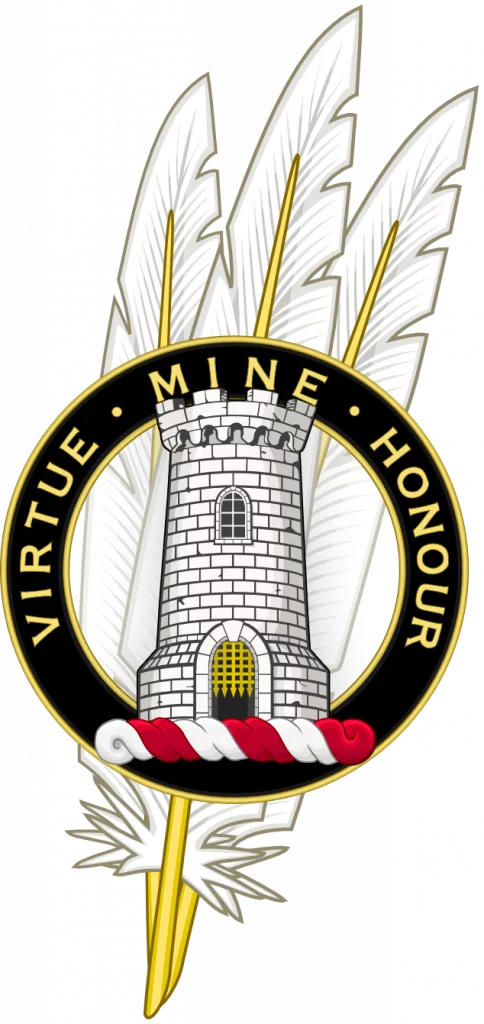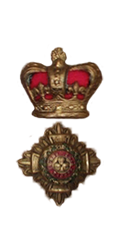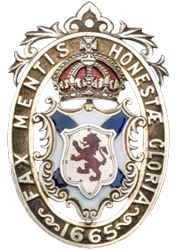25th Chief, 9th Baronet of Morvern, 21st Laird of Duart, KCB, DL, 5th Lord Maclean*
Colonel Sir Charles Fitzroy Maclean, 9th Baronet of Duart and Morvern, 5th Lord Maclean1 became the 25th Chief of the Clan Maclean on July 5th in 1847 upon the death of his father. Sir Charles was the first Maclean Chief in several generations to undertake a serious effort to perpetuate his Clan and preserve its ancient history. A rather tall and attractive man, he was remembered as being pleasant and well-liked.2
An expert in affairs of the Macleans,1 Sir Charles’ dedication to preserving the ancient history, customs, and dress of the Highlanders1 was, in many respects, the spark that ignited a renaissance of the Clan Maclean in the generations that followed. Though Sir Charles often sailed to Mull with his family his son observed that Sir Charles never stepped foot on the island,3 refusing to personally land while the Macleans were not in possession of Duart Castle. Aboard his yacht, Sir Charles would entertain members of the clan who wished to visit their chief, while his children explored the ancient ruins of Duart Castle.1 While at anchor in the shadow of the ruin, Sir Charles told his children stories of their ancestors and their clan. On one such trip in 1850, his fifteen year old son, Fitzroy,3 vowed to regain and restore the ancient stronghold.1

Service
1813 Gentleman Cadet, Royal Military college4
1816 Lieutenant, British Army, 3rd Regiment of Foot5
1819c Captain, British Army, 72nd Regiment of Foot6
1822 Captain, British Army, 40th Regiment of Foot7
1823 Captain, British Army, 81st Regiment of Foot8
1826 Major, British Army, 81st Regiment of Foot9
1832 Lieutenant-Colonel, British Army, 81st Regiment of Foot,10 Commanding14
1846 Military Secretary of Gibraltar, Unattached11
1846 Colonel, British Army, Unattached12
1848 Lieutenant Colonel, British Army, 13th Light Dragoons,13 Commanding14
Retired13
Honors
1855 Awarded the Crimean Medal14
Awarded the Turkish War Medal14
1847 9th Baronet of Morvern28
5th Lord Maclean9
Family
Sir Charles was born on the 14th of October, 178914 in the West Indies to General Sir Fitzroy Maclean and Elizabeth Kidd. It was not until 1806 that Sir Charles’ parents brought him to visit Britain for the first time;2 by 1815, his father’s military career allowed the family’s return home from the hot climate of the West Indies. Though he had several siblings, all but he and one brother, Donald, survived early childhood abroad. Sir Charles brother, Donald was a barrister and Member of Parliament.14
On May 10th, 1831 Sir Charles married Emily Eleanor Marsham in in Wateringbury, Kent.2 Emily was the daughter of the Hon. Rev. Jacob Marsham, DD, a Canon of Windsor. Together they had five children: Donald Fitzroy, Emily Frances Harriet, Louisa Marianne, Fanny Henrietta, and Georgina Marcia.14
Only seven years after their wedding, Emily passed away on the 12th of April, 1838, while in childbirth.14 Both she and the infant, named Emily Frances Harriet, were buried in Gibralter.1 Miss Marianne Marsham, Emily’s sister willingly stepped in to help raise the children, remaining with the family until her own death in 1889.1 Sir Charles never remarried.
The children of Sir Charles and Emily married well. Fitzroy married Constance Marianne Ackers, the younger daughter of George Holland Ackers, High Sheriff of Cheshire. Louisa Marianne married the Hon. Ralph Pelham Nevill, second son of the Earl of Abergavenny. Fanny Henrietta married Admiral Lord Arthur Hood, 1st Baron Hood of Avalon, of the Royal Navy, and was styled the Baroness Hood of Avalon.14 Georgina Marcia married Lord John Rolls, 1st Baron Llangattock of The Hendre; she was styled the Baroness Llangattock.1
Military Service
The son a British Army General, Sir Charles was educated at the most respected academic institutions of his day. He graduated from Eton College in 181115 and thereafter entered the Royal Military College, Sandhurst4 on the 5th of October in 1813. Sir Charles studied at Sandhurst for just over three years, leaving on the 24th of December in 1816, after purchasing his commission as a lieutenant4 with the Scots Fusilier Guards in October of 1816.5 For more than two centuries, Maclean Chiefs have honored the tradition serving with the Scots Guards.1
Sir Charles’ military service kept him abroad much of his career. While commanding13 the 81st Regiment of Foot in Dublin, his son and heir, Fitzroy, was born.1 In 1839,11 Sir Charles retired from his regiment to serve as the Military Secretary of Gibraltar; he remained in that position, and unattached from any regiment,13 for almost a decade.16 In 1843 Sir Charles would have witnessed the accidental sinking of the USS Missouri, one of the first steamships in the United States Navy. Sir Charles also served in Malta before returning home to England.1
In late June of 1848, Sir Charles retired from military service. In appreciation for his long service abroad, hours before his retirement he was first attached to the 13th Light Dragoons as their Commanding Lieutenant-Colonel.13
Later Years
Sir Charles returned to Great Britain in 1849, where he would remain the rest of his life. He had a home in London, though he spent most of his time on Kent coast in Folkestone.1 A life-long sailor,2 Sir Charles took great pleasure in navigating his yacht1 around the British Isles, particularly along the costs of the Hebrides as his ancestors had for centuries. During his time in Gibraltar and Malta, his yacht provided ample opportunity to explore the coastlines of the Mediterranean Sea and European North Atlantic. Sir Charles somehow always managed to sail to Cowes during the week of the Royal Regatta.1
In retirement Sir Charles remained a close friend of the Duke of Connaught, son of Queen Victoria.1 Sir Charles also enjoyed member in the United Service Club.17 An expert on Highland customs, Sir Charles took a leading role in opposing the proposed abandonment of Highland dress used in the uniforms of the Scottish Regiments.1
Sir Charles passed away on the 27th of December, 188314 at West Cliffe House,1 his home in Folkestone. The Chiefship and baronetcy fell to his son, Sir Fitzroy Donald Maclean. One journalist writing for the Folkestone Chronicle noted at the time, “A more liberal-minded gentleman, one more generally respected, we shall not have to reside with us again, and whilst his advanced age rendered death a visitor that must be expected, the community will feel that it has sustained a loss in this high souled gentleman which will not soon be replaced.“14


References
* Lord Maclean of the Jacobite Peerage
- The Jacobite Peerage, Baronetage, Knightage and Grants of Honour. T.C. and E.C. Jack: Edinburgh, 1904. p103 ↩︎
- Mclean, A. Sinclair. The Clan Gillean. Haszard and Moore: Charlottetown, 1899. Print 471-472. ↩︎
- Maclean-Bristol, Nicholas, From Clan to Regiment. South Yorkshire: Pen and Sword, 2007. Print. p 626. ↩︎
- RMC Sandhurst Cadet Register. 24 Dec. 1816. Archive Image ID: 4273pge00175. Sandhurst Royal Military Academy, Sandhurst, England, United Kingdom. ↩︎
- “Issue 17183.” The London Gazette 19 Oct. 1816: 1994. Print. ↩︎
- “Issue 17785.” The London Gazette 26 Jan. 1822: 154. Print. ↩︎
- “Issue 17785.” The London Gazette 26 Jan. 1822: 154. Print. ↩︎
- “Issue 17949.” The London Gazette 16 Aug. 1823: 1342. Print. ↩︎
- “Issue 18273.” The London Gazette 01 Aug. 1826: 1894. Print. ↩︎
- “Issue 18917.” The London Gazette 16 Mar. 1832: 594. Print. ↩︎
- “Issue 19782.” The London Gazette 25 Oct. 1839: 1992. Print. ↩︎
- “Suppliment 20660.” The London Gazette 10 Nov. 1846: 3989. Print. ↩︎
- “Issue 20870.” The London Gazette 23 June 1848: 2351. Print. ↩︎
- Maclean, J. P. A History of the Clan MacLean from Its First Settlement at Duard Castle, in the Isle of Mull, to the Present Period. Cincinnati: R. Clarke, 1889. 230-231. Print. ↩︎
- Stapylton, H.E.C. Eton School Lists 1791-1850. London, England: E P Williams, 1863. p74. ↩︎
- Dod, Robert P. The Peerage, Baronetage and Knightage of Great Britáin and Ireland for 1863 Including All the Titled Classes Twenty – Third Year. Whittaker and Company, 1863. p393 ↩︎
- Mair, Robert H., ed. Debrett’s Baronetage and Knightage 1879. Library Edition Vol. 71. London: Dean & Son, 1879. Print. p290. ↩︎
